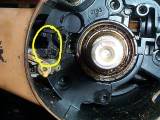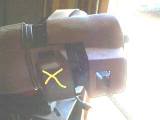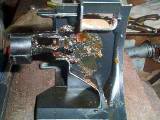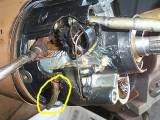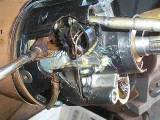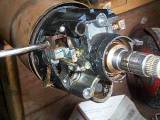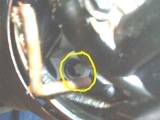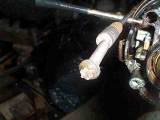How To Tighten a Loose Steering Column
Since there's already and excellent write up about replacing the lock cylinder, (Ignition Lock Cylinder Removal), I'll start from the point where everything has been removed to gain access to remove it. You will need to remove the LC to do this job. Remove the three Torx head screws which attach the housing to the column. The piece circled is part of the actuator for the high beam switch. When you slide the housing off leave this cover in place for the moment. Although not absolutely necessary, you can remove the tilt lever.
Once the housing is removed either slide the cover off over the tilt lever or just pull the cover off if you've removed the lever. It will look like this on the backside.
You'll notice a curved rod once the cover is removed, this is the actuator rod for the dimmer switch. Leave it in place. You'll also notice the piece on the cover has a curved surface that matches the curve of the rod. When you reinstall everything it's important that these two pieces line up properly. More on that later.
Now we're getting to the fun part. With the tilt in the full up position take a #2 or a #3 Phillips screwdriver, insert in the square opening, push down slightly and turn counter clockwise. This has a large spring underneath.
Remove the cap and spring, it will look like this.
You'll now need to remove the nylon gear which engages the actuator for the ignition switch. There's a small 1/4" head screw which holds the spring to the housing. Remove this and rotate the spring up out of the way. The nylon gear can now be removed from the rod which goes over to the lock cylinder. Use a small screwdriver to push the rod out of the center of the gear, remove the gear, remove the spring from the rod, which is the steering wheel lock pawl. This is what engages the lock plate you removed under the steering wheel.
These are the bolts we've come all this way looking for. There's actually four of them, we're only worried about three of them. To get at the fourth one requires a bit more disassembly and something you want to avoid if at all possible. Tightening three of the four bolts will accomplish the same thing. These are the two easier to get at lower bolts.
Believe it or not you can see the third bolt. Does not show up in the picture but you will see it in there.
Still with me? This is the best tool I've ever found for getting at these Torxhead bolts. This is a Craftsman but any hexdrive screwdriver will work as long as it has a thin shank. The longer the shank the better.
Starting with the easiest to get at remove the bolt. A small magnet may come in handy at this point or a small pair of needle nose pliers. I find a magnet works best, the small type that looks like a pointer and has the collapseable shaft. You may want to tighten up one or both of the other bolts slightly, this will help keep things aligned. This is what the bolts look like.
Clean the threads, apply Loc-Tite or the thread locker of your choice, reinstall bolt and tighten. I generally only remove the two bottom bolts and apply Loc-Tite to those as the third one, the one you can't see very well, can be a real pain to get out. I've done more of these than I care remember and have never had a problem. I can only recall maybe one or two that I had to totally disassemble and that was because that fourth screw had fallen out. The customer had waited to long to do something about his loose steering.
So, if you're still with me we now need to put this thing back together. Pretty straight forward, reassembly is the reverse of disassembly. Then you get to the cover with the slider piece there's one thing to remember. That grease is there for two reasons. One is to lubricate, the other is to hold that sucker in there when you're putting it back together. In the picture that slider is shown all the way extended. It must be in this position to engage that curved metal rod mentioned earlier. Probably the hardest part is getting that slider and the pin aligned when putting the housing back on. It can be a little tricky but patience goes a long way. And yes, sometimes, when all else fails, it really does help to stick out and hold your tongue just the right way. Unfortunately I can't help you with that.
